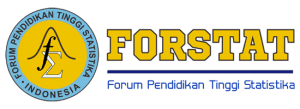ANALISIS KETERKAITAN ANTAR KELOMPOK PENGELUARAN INFLASI MENGGUNAKAN VECTOR AUTOREGRESSIVE MODEL
Abstract
In this study, testing steps were carried out, namely the stationarity test, determining the optimum lag, hypothesis testing and the formation of the VAR model, the Granger causality test and classical assumptions. The data used are month to month inflation data for each inflation expenditure group in Indonesia for the period January 2013 to December 2019. The inflation expenditure group is foodstuffs; processed food, beverages, cigarettes and tobacco; housing, water, electricity, gas and fuel; clothing; health; education, recreation and sports; and transportation, communication, and financial services. However, in this study only five inflation expenditure groups were used, namely foodstuffs; processed food, beverages, cigarettes and tobacco; housing, water, electricity, gas and fuel; clothing; as well as transportation, communication and financial services. The purpose of this study is to analyze the relationship between inflation expenditure groups and to find a forecasting model for inflation expenditure groups in Indonesia. After the Granger causality test was carried out, all probability values between endogenous variables, namely the five groups of inflation expenditures were less than 0,05 or rejected H0. Therefore, it can be concluded that there is a causal relationship between endogenous variables.
Keywords
Full Text:
PDFReferences
Enders, W. (2010), Applied Econometric Times Series. (Student Resource Guide for RATS and EVIEWS), John Wiley & Sons Inc, New York.
Granger, C. W. J. (1969), “Investigating Causal Relations by Econometric Models and Cross-spectral Methods,” Econometrica, 37. https://doi.org/10.2307/1912791.
Gujarati, D. N. (2004), Basic Econometrics 4th Edition, Tata McGraw-Hill.
Jones, L. E., and Manuelli, R. E. (1995), “Growth and the effects of inflation,” Journal of Economic Dynamics and Control, 19. https://doi.org/10.1016/0165-1889(94)00835-6.
Mankiw, N. G. (2012), Principles of Economics 6th Edition, Cengage Learning.
Nachrowi, D., and Usman, H. (2004), “Pendekatan Populer dan Praktis Ekonometrika untuk Analisis Ekonomi dan Keuangan,” The Journal of Finance, 23.
Setiawan, W. (2010), “Analisis Dampak Fluktuasi Perekonomian Dunia terhadap Efektifitas Kebijakan Moneter,” Universitas Indonesia.
Sims, C. A. (1972), “Money, Income, and Causality,” American Economic Review.
Widarjono, A. (2013), Ekonometrika : Pengantar dan Aplikasinya, Jakarta : Ekonosia.
DOI: https://doi.org/10.34312/jjps.v2i1.7763
Refbacks
- There are currently no refbacks.
Copyright (c) 2021 Jambura Journal of Probability and Statistics

This work is licensed under a Creative Commons Attribution-NonCommercial 4.0 International License.







.jpg)






